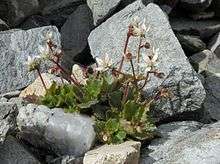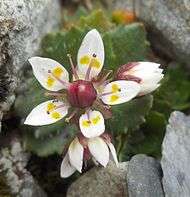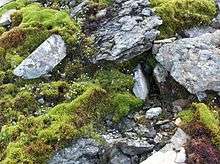Saxifraga stellaris
Saxifraga stellaris, the starry saxifrage or hairy kidney-wort, is an Arctic–alpine species of saxifrage.[2] It produces panicles of 5–10 white flowers on a stem up to 20 cm (7.9 in) tall, rising from a basal leaf rosette. One subspecies is found from eastern Canada to Russia, including the British Isles, while another is found in the mountains of southern Europe.
| Saxifraga stellaris | |
|---|---|
 | |
| S. stellaris subsp. stellaris | |
| Scientific classification | |
| Kingdom: | |
| (unranked): | |
| (unranked): | |
| (unranked): | Core eudicots |
| Order: | |
| Family: | |
| Genus: | |
| Section: | |
| Species: | S. stellaris |
| Binomial name | |
| Saxifraga stellaris | |
| Subspecies | |
| |
| Synonyms [1] | |
|
Micranthes stellaris (L.) Galasso, Banfi & Soldano | |
Description

Saxifraga stellaris grows as a leaf rosette, which produces a generally leafless stem up to 20 centimetres (7.9 in) tall.[3] The leaves are toothed and somewhat fleshy, ovate or obovate, and without an obvious petiole.[2][4] They are typically 3 cm (1.2 in) long (varying from 1 to 5 centimetres or 0.4 to 2.0 inches), with a cuneate (wedge-shaped) base.[2][5][6]
The flowers are borne in a loose panicle comprising 5–10 flowers;[2][3] each flower has deflexed sepals, surrounding five white petals, 3–6 millimetres (0.12–0.24 in) long, with two yellow or red spots near the base.[2][3] The anthers are also red or yellow.[4] Flowers are borne from June to August.[2][4]
The seeds are dark brown, glabrous, 0.6–0.8 mm (0.024–0.031 in) long, and 0.3–0.4 mm (0.012–0.016 in) wide. They are elliptic, ovoid or reniform in shape, with longitudinal ribs bearing spines.[7] S. stellaris has a chromosome number of 2n = 28.[3][5][7]
Distribution and ecology

Saxifraga stellaris has an Arctic–alpine distribution.[2] It is found from Baffin Island, Labrador and Greenland to Arctic Russia, including Iceland, Scandinavia and the British Isles.[4][5] Further south, it is found from the Sierra Nevada in southern Spain to the eastern Carpathians,[7][8] including lower ranges such as the Massif Central.[1]
In the Arctic, S. stellaris may occur down to sea level. Within the British Isles, S. stellaris is abundant in North Wales, Northern England and Scotland, reaching the summit of Ben Nevis (1,344 m or 4,409 ft), but is only found locally in Ireland.[3][4][9] Its southernmost stations in Great Britain are the slopes of Plynlimon and the Rheidol valley; it does not occur in the mountains of South Wales.[10] In the Vosges, it occurs around 3,600 ft (1,100 m), but only rarely below 4,300–4,600 ft (1,300–1,400 m) in the Swiss Alps.[11] In the Sierra Nevada of southern Spain, it lives at up to 3,350 m (10,990 ft).[1]
Saxifraga stellaris lives in damp environments, such as wet flushes, beside streams or springs, or on wet rock ledges.[5][6][9] It is self-compatible, but its flowers are protandrous, and are usually pollinated by flies.[1]
Taxonomy
Saxifraga stellaris was first described by Carl Linnaeus in his 1753 work Species Plantarum.[8][12] Linnaeus noted the species' occurrence in the mountains of Spitsbergen, Lapland, Switzerland, Styria and Westmorland.[12] The nominate subspecies, Saxifraga stellaris subsp. stellaris is the northern subspecies, occurring from Canada to Russia, including the British Isles.[8] The subspecies in the Alpide belt and other mountains in southern Europe is often called S. stellaris subsp. alpigena, but an older name has priority – S. stellaris subsp. robusta.[8] The name S. stellaris subsp. prolifera is used for plants from the south-eastern Alps which have few flowers but produce bulbils along the stems.[2][13]
References
- Matthias Kropf, Hans P. Comes & Joachim W. Kadereit (2008). "Causes of the genetic architecture of south-west European high mountain disjuncts". Plant Ecology & Diversity. 1 (2): 217–228. doi:10.1080/17550870802331938.
- Manfred A. Fischer, Wolfgang Adler & Karl Oswald (2005). "Steinbrechblütige / Saxifraganae". Exkursionsflora für Österreich, Liechtenstein und Südtirol (in German). Linz: Oberösterreichische Landesmuseen. p. 397. ISBN 978-3-85474-140-4.
- Clive A. Stace (2010). New Flora of the British Isles (3rd ed.). Cambridge: Cambridge University Press. p. 130. ISBN 978-0-521-70772-5.
- Heather Pardoe (1995). Mountain Plants of the British Isles. British Plant Life. 4. Cardiff: National Museums and Galleries of Wales. p. 44. ISBN 978-0-7200-0423-6.
- Luc Brouillet & Patrick E. Elvander (2009). "Micranthes stellaris (Linnaeus) Galasso, Banfi & Soldano, Atti Soc. Ital. Sci. Nat. Mus. Civico Storia Nat. Milano. 146: 231. 2005". Magnoliophyta: Paeoniaceae to Ericaceae. Flora of North America. 8. Oxford University Press. p. 57. ISBN 978-0-19-534026-6.
- James Ferguson-Lees & Bruce Campbell, ed. (1978). Mountains and Moorlands. The Natural History of Britain and Northern Europe. George Rainbird. p. 104. ISBN 978-0-340-22615-5.
- Vít Bojňanský & Agáta Fargašová (2007). Atlas of Seeds and Fruits of Central and East-European Flora: The Carpathian Mountains Region. Springer. p. 239. ISBN 978-1-4020-5361-0.
- Pablo Vargas (2003). "Saxifraga L.". Ebenaceae–Saxifragaceae. Flora Ibérica (in Spanish). 5 (2nd ed.). Consejo Superior de Investigaciones Científicas. pp. 170–171. ISBN 978-84-00-07641-2.
- Christopher David Preston, D. Pearman & Trevor D. Dines (2002). "Saxifraga stellaris (starry saxifrage)". New Atlas of the British & Irish Flora: an Atlas of the Vascular Plants of Britain, Ireland, the Isle of Man and the Channel Islands. 1. Oxford University Press. ISBN 978-0-19-851067-3.
- J. L. Davies & D. P. Kirby (1994). Cardiganshire County History: from the Earliest Times to the Coming of the Normans. Cardiganshire County History. 1. University of Wales Press. p. 74. ISBN 978-0-7083-1170-7.
- Arthur Henfrey (1977) [1852]. The Vegetation of Europe. Outlines of the Natural History of Europe. 1. London: J. Van Voorst. p. 225. ISBN 978-0-405-10397-1.
- Carolus Linnaeus (1753). "[Saxifraga] stellaris". Species Plantarum (in Latin). Stockholm: Laurentius Salvius. p. 400.
- Eva Schönbeck-Temesy (1954). Der Formenkreis von Saxifraga stellaris Linné [The polytypic species Saxifraga stellaris Linné] (Ph.D. thesis). University of Graz. Sub auspiciis Praesidentis.
External links

